Mapping the Soil Salinity Distribution and Analyzing Its Spatial and Temporal Changes in Bachu County, Xinjiang, Based on Google Earth Engine and Machine Learning
Abstract
:1. Introduction
2. Materials and Methods
2.1. Overview of the Study Area
2.2. Technological Approach
2.3. Data Sources and Processing
2.3.1. Ground-Truth Data
2.3.2. Remote Sensing Data
2.3.3. Spectral Indices
2.3.4. Salinity Indices
2.3.5. Composite Indices
2.3.6. Topographic Factors
2.3.7. Climatic Factors
2.4. Predictive Model
2.5. Evaluation of Model Accuracy
3. Results and Analysis
3.1. Soil Salinity Predictors
3.2. Model Accuracy Validation and Selection
3.3. Spatial and Temporal Variability of Salinization in Bachu County
3.3.1. Analysis of Spatial and Temporal Variations at the 0–20 cm Depth
3.3.2. Analysis of Spatial and Temporal Variations at the 20–40 cm Depth
3.4. Validation of Model Prediction Classification Errors
4. Discussion
4.1. Selection of Model Indices
4.2. Validation of the Model Accuracy and Classification Error
4.3. Analysis of Spatial and Temporal Changes in Soil Salinization and Their Influencing Factors in Bachu County
4.4. Future Prospects and Challenges
5. Conclusions
Author Contributions
Funding
Institutional Review Board Statement
Data Availability Statement
Conflicts of Interest
References
- Li, J.; Pu, L.; Han, M.; Zhu, M.; Zhang, R.; Xiang, Y. Soil salinization research in China: Advances and prospects. J. Geogr. Sci. 2014, 24, 943–960. [Google Scholar] [CrossRef]
- Wang, H.; Jia, G. Satellite-based monitoring of decadal soil salinization and climate effects in a semi-arid region of China. Adv. Atmos. Sci. 2012, 29, 1089–1099. [Google Scholar] [CrossRef]
- Bouksila, F.; Bahri, A.; Berndtsson, R.; Persson, M.; Rozema, J.; Van der Zee, S.E. Assessment of soil salinization risks under irrigation with brackish water in semiarid Tunisia. Environ. Exp. Bot. 2013, 92, 176–185. [Google Scholar] [CrossRef]
- Cañedo-Argüelles, M.; Kefford, B.J.; Piscart, C.; Prat, N.; Schäfer, R.B.; Schulz, C.-J. Salinisation of rivers: An urgent ecological issue. Environ. Pollut. 2013, 173, 157–167. [Google Scholar] [CrossRef] [PubMed]
- Tanji, K.K. Nature and extent of agricultural salinity. Agric. Salin. Assess. Manag. 1990, 71–92. Available online: https://www.encyclopedie-environnement.org/zh/zoom/land-salinization/ (accessed on 9 April 2024).
- Panah, A.; Kazem, S.; McKenzie, N. Status of the world’s soil resources main report. Available online: http://www.alice.cnptia.embrapa.br/alice/handle/doc/1034770 (accessed on 9 April 2024).
- Scudiero, E.; Skaggs, T.H.; Corwin, D.L. Simplifying field-scale assessment of spatiotemporal changes of soil salinity. Sci. Total Environ. 2017, 587, 273–281. [Google Scholar] [CrossRef] [PubMed]
- Dent, D.; Young, A. Soil Survey and Land Evaluation; George Allen & Unwin: Sydney, NSW, Australia, 1981. [Google Scholar]
- Nanni, M.R.; Demattê, J.A.M. Spectral reflectance methodology in comparison to traditional soil analysis. Soil Sci. Soc. Am. J. 2006, 70, 393–407. [Google Scholar] [CrossRef]
- Dehaan, R.; Taylor, G. Field-derived spectra of salinized soils and vegetation as indicators of irrigation-induced soil salinization. Remote Sens. Environ. 2002, 80, 406–417. [Google Scholar] [CrossRef]
- Asfaw, E.; Suryabhagavan, K.; Argaw, M. Soil salinity modeling and mapping using remote sensing and GIS: The case of Wonji sugar cane irrigation farm, Ethiopia. J. Saudi Soc. Agric. Sci. 2018, 17, 250–258. [Google Scholar] [CrossRef]
- Gorji, T.; Sertel, E.; Tanik, A. Monitoring soil salinity via remote sensing technology under data scarce conditions: A case study from Turkey. Ecol. Indic. 2017, 74, 384–391. [Google Scholar] [CrossRef]
- Mougenot, B.; Pouget, M.; Epema, G. Remote sensing of salt affected soils. Remote Sens. Rev. 1993, 7, 241–259. [Google Scholar] [CrossRef]
- Wang, Z.; Zhang, F.; Zhang, X.; Chan, N.W.; Ariken, M.; Zhou, X.; Wang, Y. Regional suitability prediction of soil salinization based on remote-sensing derivatives and optimal spectral index. Sci. Total Environ. 2021, 775, 145807. [Google Scholar] [CrossRef]
- Zhang, Z.; Fan, Y.; Zhang, A.; Jiao, Z. Baseline-Based Soil Salinity Index (BSSI): A Novel Remote Sensing Monitoring Method of Soil Salinization. IEEE J. Sel. Top. Appl. Earth Obs. Remote Sens. 2022, 16, 202–214. [Google Scholar] [CrossRef]
- Ding, J.-L.; Wu, M.-C.; Liu, H.-X.; Li, Z.-G. Study on the soil salinization monitoring based on synthetical hyperspectral index. Spectrosc. Spectr. Anal. 2012, 32, 1918–1922. [Google Scholar]
- Triki Fourati, H.; Bouaziz, M.; Benzina, M.; Bouaziz, S. Detection of terrain indices related to soil salinity and mapping salt-affected soils using remote sensing and geostatistical techniques. Environ. Monit. Assess. 2017, 189, 177. [Google Scholar] [CrossRef] [PubMed]
- El Harti, A.; Lhissou, R.; Chokmani, K.; Ouzemou, J.-E.; Hassouna, M.; Bachaoui, E.M.; El Ghmari, A. Spatiotemporal monitoring of soil salinization in irrigated Tadla Plain (Morocco) using satellite spectral indices. Int. J. Appl. Earth Obs. Geoinf. 2016, 50, 64–73. [Google Scholar] [CrossRef]
- Wu, D.; Jia, K.; Zhang, X.; Zhang, J.; Abd El-Hamid, H.T. Remote sensing inversion for simulation of soil salinization based on hyperspectral data and ground analysis in Yinchuan, China. Nat. Resour. Res. 2021, 30, 4641–4656. [Google Scholar] [CrossRef]
- Shi, H.; Hellwich, O.; Luo, G.; Chen, C.; He, H.; Ochege, F.U.; Van de Voorde, T.; Kurban, A.; De Maeyer, P. A global meta-analysis of soil salinity prediction integrating satellite remote sensing, soil sampling, and machine learning. IEEE Trans. Geosci. Remote Sens. 2021, 60, 4505815. [Google Scholar] [CrossRef]
- Jiang, H.; Shu, H. Optical remote-sensing data based research on detecting soil salinity at different depth in an arid-area oasis, Xinjiang, China. Earth Sci. Inform. 2019, 12, 43–56. [Google Scholar] [CrossRef]
- Wang, Q.; Li, P.; Chen, X. Retrieval of soil salt content from an integrated approach of combining inversed reflectance model and regressions: An experimental study. IEEE Trans. Geosci. Remote Sens. 2012, 50, 3950–3957. [Google Scholar] [CrossRef]
- Barbouchi, M.; Abdelfattah, R.; Chokmani, K.; Aissa, N.B.; Lhissou, R.; El Harti, A. Soil salinity characterization using polarimetric InSAR coherence: Case studies in Tunisia and Morocco. IEEE J. Sel. Top. Appl. Earth Obs. Remote Sens. 2014, 8, 3823–3832. [Google Scholar] [CrossRef]
- Zhang, Q.; Li, L.; Sun, R.; Zhu, D.; Zhang, C.; Chen, Q. Retrieval of the soil salinity from Sentinel-1 Dual-Polarized SAR data based on deep neural network regression. IEEE Geosci. Remote Sens. Lett. 2020, 19, 4006905. [Google Scholar] [CrossRef]
- Tian, A.; Fu, C.; Yau, H.-T.; Su, X.-Y.; Xiong, H. A new methodology of soil salinization degree classification by probability neural network model based on centroid of fractional lorenz chaos self-synchronization error dynamics. IEEE Trans. Geosci. Remote Sens. 2019, 58, 799–810. [Google Scholar] [CrossRef]
- Ma, S.; He, B.; Ge, X.; Luo, X. Spatial prediction of soil salinity based on the Google Earth Engine platform with multitemporal synthetic remote sensing images. Ecol. Inform. 2023, 75, 102111. [Google Scholar] [CrossRef]
- Dong, J.; Xiao, X.; Menarguez, M.A.; Zhang, G.; Qin, Y.; Thau, D.; Biradar, C.; Moore III, B. Mapping paddy rice planting area in northeastern Asia with Landsat 8 images, phenology-based algorithm and Google Earth Engine. Remote Sens. Environ. 2016, 185, 142–154. [Google Scholar] [CrossRef] [PubMed]
- Xiong, J.; Thenkabail, P.S.; Tilton, J.C.; Gumma, M.K.; Teluguntla, P.; Oliphant, A.; Congalton, R.G.; Yadav, K.; Gorelick, N. Nominal 30-m cropland extent map of continental Africa by integrating pixel-based and object-based algorithms using Sentinel-2 and Landsat-8 data on Google Earth Engine. Remote Sens. 2017, 9, 1065. [Google Scholar] [CrossRef]
- Parastatidis, D.; Mitraka, Z.; Chrysoulakis, N.; Abrams, M. Online global land surface temperature estimation from Landsat. Remote Sens. 2017, 9, 1208. [Google Scholar] [CrossRef]
- Brovelli, M.A.; Sun, Y.; Yordanov, V. Monitoring forest change in the amazon using multi-temporal remote sensing data and machine learning classification on Google Earth Engine. ISPRS Int. J. Geo-Inf. 2020, 9, 580. [Google Scholar] [CrossRef]
- Zhang, W.; Cao, L.; Yu, S.; Zhou, X. Study on Surface and Internal Humidity of Dunes in the Southwestern Margin of the Taklimakan Desert. In Proceedings of the 2nd International Conference on Green Energy, Environment and Sustainable Development (GEESD2021), Shanghai, China, 26–27 June 2021; p. 462. [Google Scholar]
- Mamat, A.; Halik, Ü.; Rouzi, A. Variations of ecosystem service value in response to land-use change in the Kashgar Region, Northwest China. Sustainability 2018, 10, 200. [Google Scholar] [CrossRef]
- Jiang, P. Soil Improvement and Fertilization; Xinjiang People’s Publishing House: Urumqi, China, 2012; pp. 121–148. [Google Scholar]
- Luo, C.; Zhang, X.; Meng, X.; Zhu, H.; Ni, C.; Chen, M.; Liu, H. Regional mapping of soil organic matter content using multitemporal synthetic Landsat 8 images in Google Earth Engine. Catena 2022, 209, 105842. [Google Scholar] [CrossRef]
- Zhang, J.; Zhang, Z.; Chen, J.; Chen, H.; Jin, J.; Han, J.; Wang, X.; Song, Z.; Wei, G. Estimating soil salinity with different fractional vegetation cover using remote sensing. Land Degrad. Dev. 2021, 32, 597–612. [Google Scholar] [CrossRef]
- Taghizadeh-Mehrjardi, R.; Minasny, B.; Sarmadian, F.; Malone, B. Digital mapping of soil salinity in Ardakan region, central Iran. Geoderma 2014, 213, 15–28. [Google Scholar] [CrossRef]
- Mejia-Cabrera, H.I.; Vilchez, D.; Tuesta-Monteza, V.; Forero, M.G. Soil salinity estimation of sparse vegetation based on multispectral image processing and machine learning. In Proceedings of the Applications of Digital Image Processing XLIII, Online, 24 August–4 September 2020; pp. 81–90. [Google Scholar]
- Hongyan, C.; Gengxing, Z.; Jingchun, C.; Ruiyan, W.; Mingxiu, G. Remote sensing inversion of saline soil salinity based on modified vegetation index in estuary area of Yellow River. Trans. Chin. Soc. Agric. Eng. 2015, 31, 107–114. [Google Scholar]
- Song, B.; Park, K. Detection of aquatic plants using multispectral UAV imagery and vegetation index. Remote Sens. 2020, 12, 387. [Google Scholar] [CrossRef]
- Rondeaux, G.; Steven, M.; Baret, F. Optimization of soil-adjusted vegetation indices. Remote Sens. Environ. 1996, 55, 95–107. [Google Scholar] [CrossRef]
- Azabdaftari, A.; Sunar, F. Soil salinity mapping using multitemporal Landsat data. Int. Arch. Photogramm. Remote Sens. Spat. Inf. Sci. 2016, 41, 3–9. [Google Scholar] [CrossRef]
- Ding, J.; Yu, D. Monitoring and evaluating spatial variability of soil salinity in dry and wet seasons in the Werigan–Kuqa Oasis, China, using remote sensing and electromagnetic induction instruments. Geoderma 2014, 235, 316–322. [Google Scholar] [CrossRef]
- Abbas, A.; Khan, S. Using remote sensing techniques for appraisal of irrigated soil salinity. In Proceedings of the International Congress on Modelling and Simulation (MODSIM), Brisbane, Australia, 10–12 December 2007; pp. 2632–2638. [Google Scholar]
- Nicolas, H.; Walter, C. Detecting salinity hazards within a semiarid context by means of combining soil and remote-sensing data. Geoderma 2006, 134, 217–230. [Google Scholar]
- Bannari, A.; Guedon, A.; El-Harti, A.; Cherkaoui, F.; El-Ghmari, A. Characterization of slightly and moderately saline and sodic soils in irrigated agricultural land using simulated data of advanced land imaging (EO-1) sensor. Commun. Soil Sci. Plant Anal. 2008, 39, 2795–2811. [Google Scholar] [CrossRef]
- Allbed, A.; Kumar, L.; Aldakheel, Y.Y. Assessing soil salinity using soil salinity and vegetation indices derived from IKONOS high-spatial resolution imageries: Applications in a date palm dominated region. Geoderma 2014, 230, 1–8. [Google Scholar] [CrossRef]
- Allbed, A.; Kumar, L.; Sinha, P. Mapping and modelling spatial variation in soil salinity in the Al Hassa Oasis based on remote sensing indicators and regression techniques. Remote Sens. 2014, 6, 1137–1157. [Google Scholar] [CrossRef]
- Al-Khaier, F. Soil salinity detection using satellite remote sensing. 2003. Available online: https://webapps.itc.utwente.nl/librarywww/papers_2003/msc/wrem/khaier.pdf (accessed on 9 April 2024).
- Tripathi, N.; Rai, B.K.; Dwivedi, P. Spatial modeling of soil alkalinity in GIS environment using IRS data. In Proceedings of the Proceedings of the 18th Asian Conference on Remote Sensing, Kuala Lumpur, Malaysia, 20–24 October 1997; pp. 20–24. [Google Scholar]
- Khan, N.M.; Rastoskuev, V.V.; Shalina, E.V.; Sato, Y. Mapping salt-affected soils using remote sensing indicators—A simple approach with the use of GIS IDRISI. In Proceedings of the 22nd Asian Conference on Remote Sensing, Singapore, 5–9 November 2001. [Google Scholar]
- Liu, J.; Zhang, L.; Dong, T.; Wang, J.; Fan, Y.; Wu, H.; Geng, Q.; Yang, Q.; Zhang, Z. The applicability of remote sensing models of soil salinization based on feature space. Sustainability 2021, 13, 13711. [Google Scholar] [CrossRef]
- Wu, Z.; Lei, S.; Bian, Z.; Huang, J.; Zhang, Y. Study of the desertification index based on the albedo-MSAVI feature space for semi-arid steppe region. Environ. Earth Sci. 2019, 78, 232. [Google Scholar] [CrossRef]
- Guo, B.; Yang, F.; Fan, Y.; Han, B.; Chen, S.; Yang, W. Dynamic monitoring of soil salinization in Yellow River Delta utilizing MSAVI–SI feature space models with Landsat images. Environ. Earth Sci. 2019, 78, 308. [Google Scholar] [CrossRef]
- Liang, S. Narrowband to broadband conversions of land surface albedo I: Algorithms. Remote Sens. Environ. 2001, 76, 213–238. [Google Scholar] [CrossRef]
- Behrens, T.; Zhu, A.-X.; Schmidt, K.; Scholten, T. Multi-scale digital terrain analysis and feature selection for digital soil mapping. Geoderma 2010, 155, 175–185. [Google Scholar] [CrossRef]
- Shokri-Kuehni, S.M.; Rad, M.N.; Webb, C.; Shokri, N. Impact of type of salt and ambient conditions on saline water evaporation from porous media. Adv. Water Resour. 2017, 105, 154–161. [Google Scholar] [CrossRef]
- Pang, G.; Wang, T.; Liao, J.; Li, S. Quantitative Model Based on Field-Derived Spectral Characteristics to Estimate Soil Salinity in Minqin County, China. Soil Sci. Soc. Am. J. 2014, 78, 546–555. [Google Scholar] [CrossRef]
- Guan, X.; Wang, S.; Gao, Z.; Lv, Y. Dynamic prediction of soil salinization in an irrigation district based on the support vector machine. Math. Comput. Model. 2013, 58, 719–724. [Google Scholar] [CrossRef]
- Aksoy, S.; Yildirim, A.; Gorji, T.; Hamzehpour, N.; Tanik, A.; Sertel, E. Assessing the performance of machine learning algorithms for soil salinity mapping in Google Earth Engine platform using Sentinel-2A and Landsat-8 OLI data. Adv. Space Res. 2022, 69, 1072–1086. [Google Scholar] [CrossRef]
- Kabiraj, S.; Jayanthi, M.; Vijayakumar, S.; Duraisamy, M. Comparative assessment of satellite images spectral characteristics in identifying the different levels of soil salinization using machine learning techniques in Google Earth Engine. Earth Sci. Inform. 2022, 15, 2275–2288. [Google Scholar] [CrossRef]
- Esposito Vinzi, V.; Russolillo, G. Partial least squares algorithms and methods. Wiley Interdiscip. Rev. Comput. Stat. 2013, 5, 1–19. [Google Scholar] [CrossRef]
- Awad, M. Google Earth Engine (GEE) cloud computing based crop classification using radar, optical images and Support Vector Machine Algorithm (SVM). In Proceedings of the 2021 IEEE 3rd International Multidisciplinary Conference on Engineering Technology (IMCET), Beirut, Lebanon, 8–10 December 2021; pp. 71–76. [Google Scholar]
- Lee, S.K. On classification and regression trees for multiple responses and its application. J. Classif. 2006, 23, 123–141. [Google Scholar] [CrossRef]
- Dhillon, M.S.; Dahms, T.; Kuebert-Flock, C.; Rummler, T.; Arnault, J.; Steffan-Dewenter, I.; Ullmann, T. Integrating random forest and crop modeling improves the crop yield prediction of winter wheat and oil seed rape. Front. Remote Sens. 2023, 3, 1010978. [Google Scholar] [CrossRef]
- Sun, Q.; Sun, J.; Baidurela, A.; Li, L.; Hu, X.; Song, T. Ecological landscape pattern changes and security from 1990 to 2021 in Ebinur Lake Wetland Reserve, China. Ecol. Indic. 2022, 145, 109648. [Google Scholar] [CrossRef]
- Wang, N.; Xue, J.; Peng, J.; Biswas, A.; He, Y.; Shi, Z. Integrating remote sensing and landscape characteristics to estimate soil salinity using machine learning methods: A case study from Southern Xinjiang, China. Remote Sens. 2020, 12, 4118. [Google Scholar] [CrossRef]
- Zhang, H.; Fu, X.; Zhang, Y.; Qi, Z.; Zhang, H.; Xu, Z. Mapping Multi-Depth Soil Salinity Using Remote Sensing-Enabled Machine Learning in the Yellow River Delta, China. Remote Sens. 2023, 15, 5640. [Google Scholar] [CrossRef]
- Filippi, P.; Cattle, S.R.; Bishop, T.F.; Pringle, M.J.; Jones, E.J. Monitoring changes in soil salinity and sodicity to depth, at a decadal scale, in a semiarid irrigated region of Australia. Soil Res. 2018, 56, 696–711. [Google Scholar] [CrossRef]

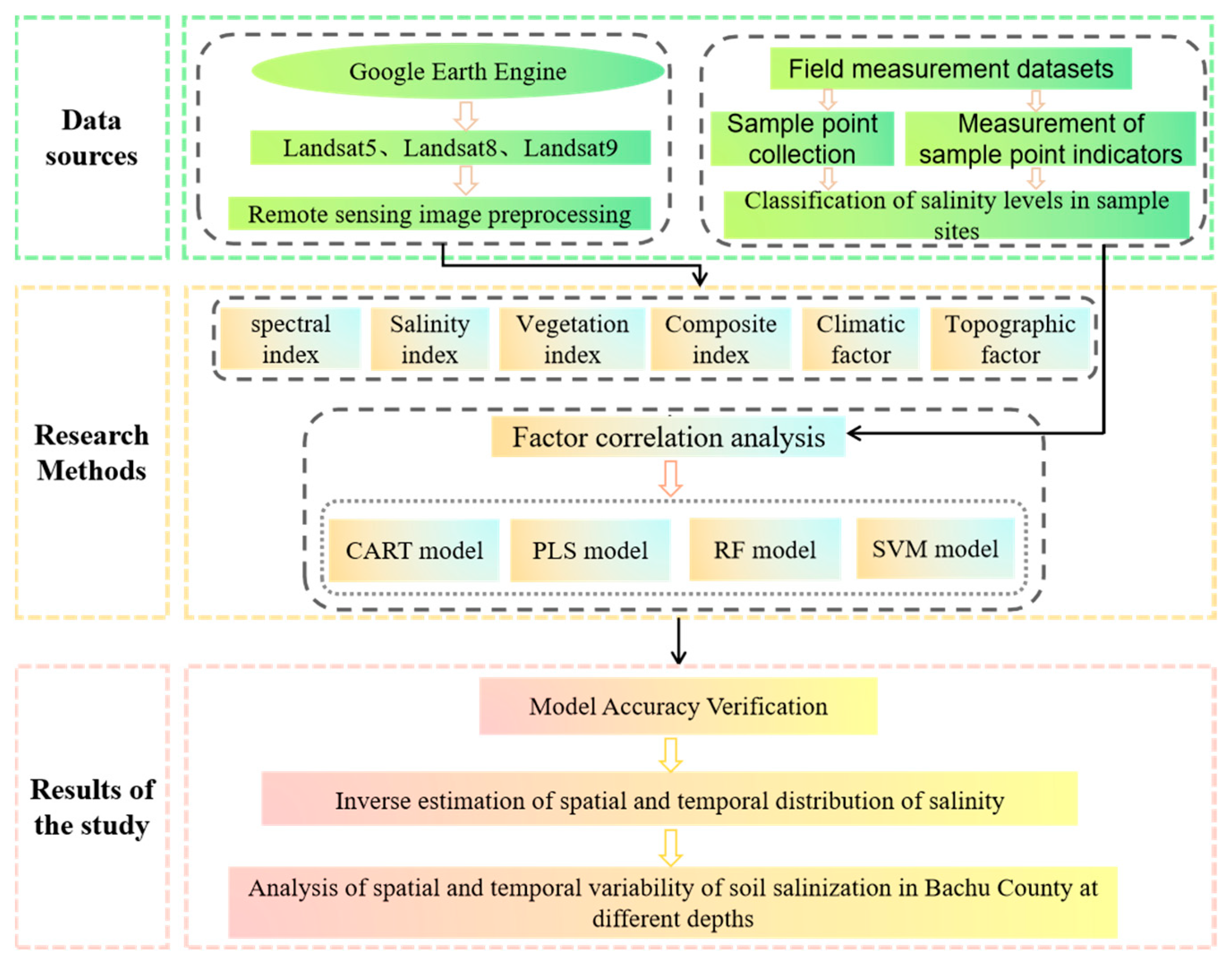
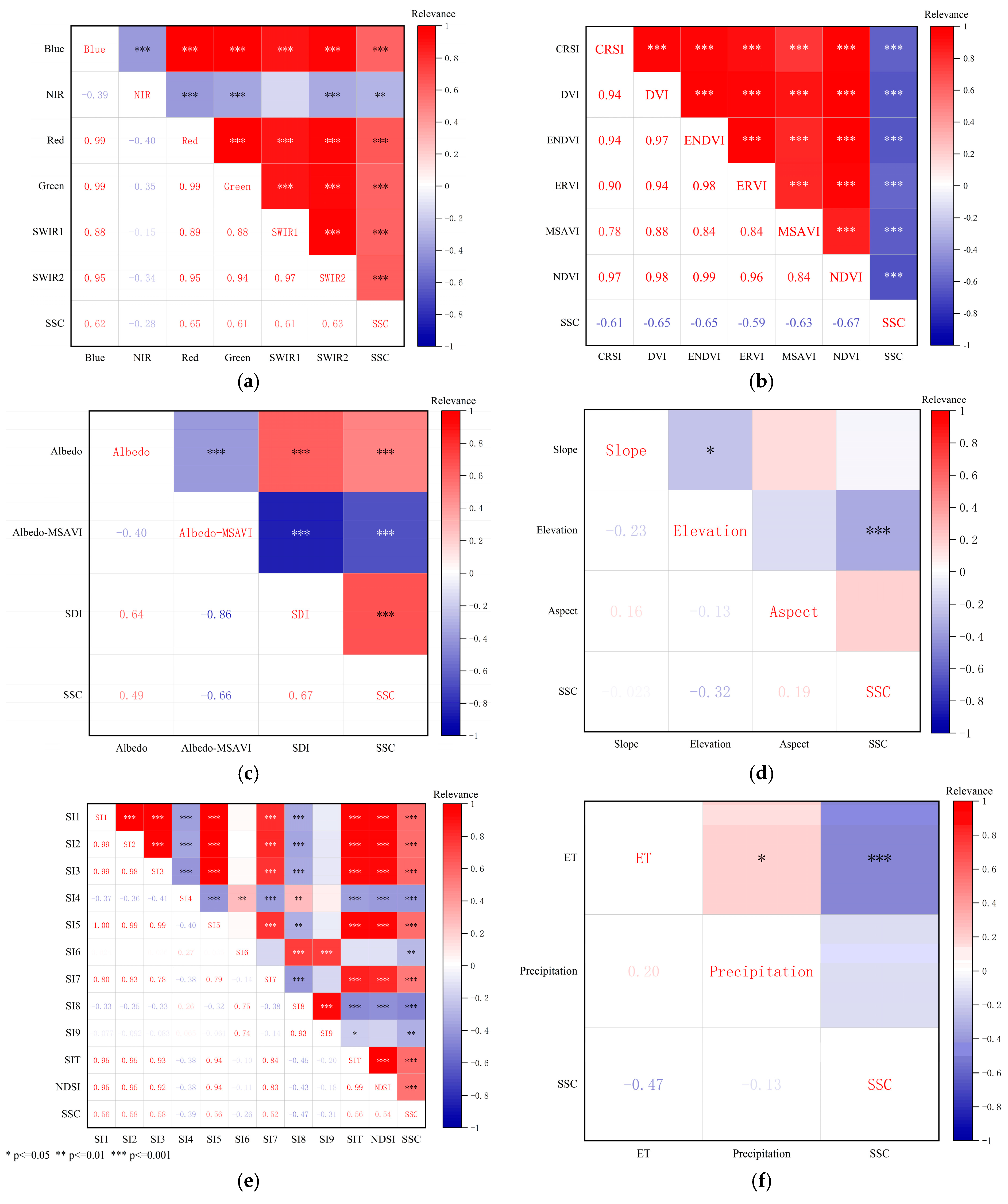


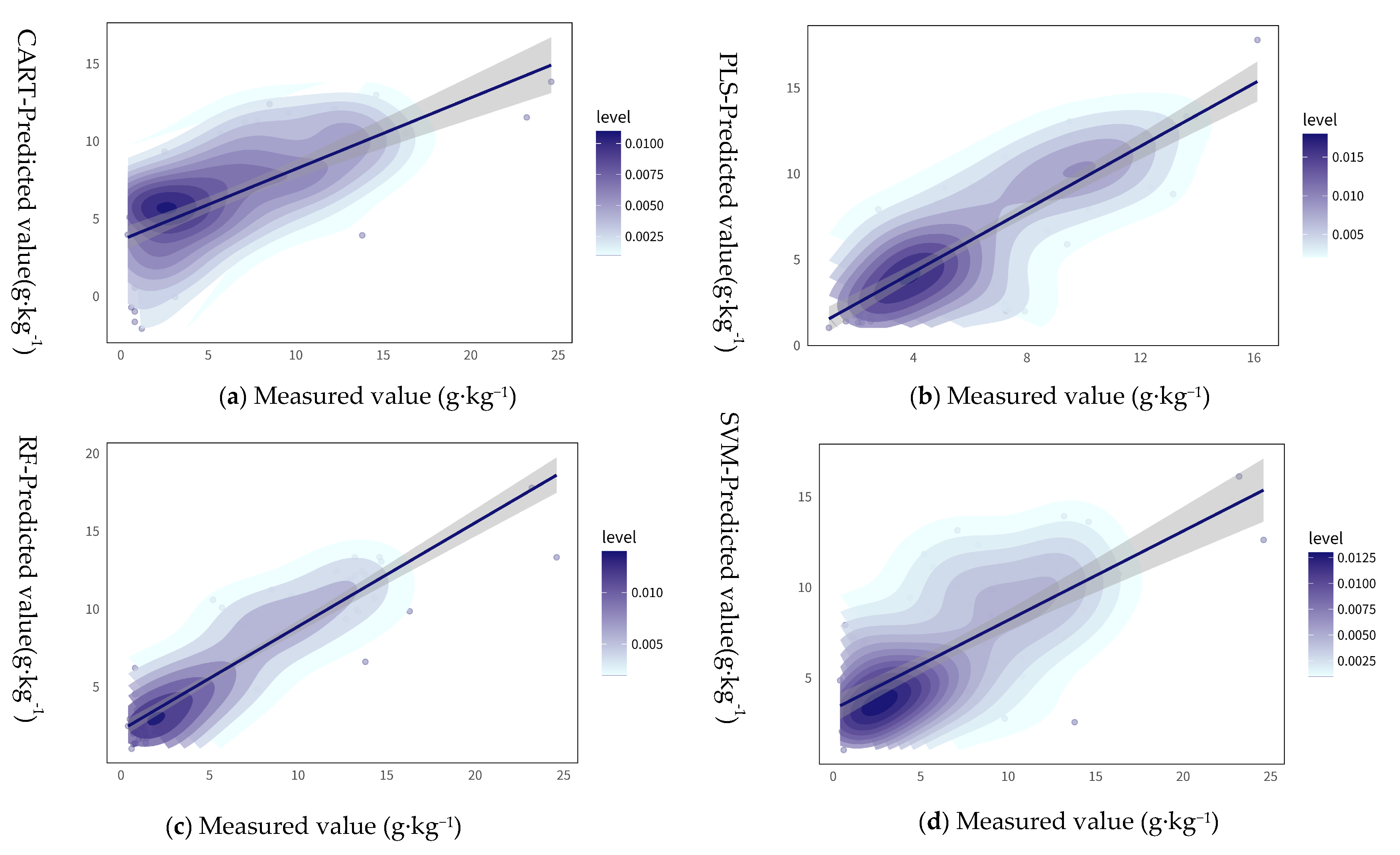
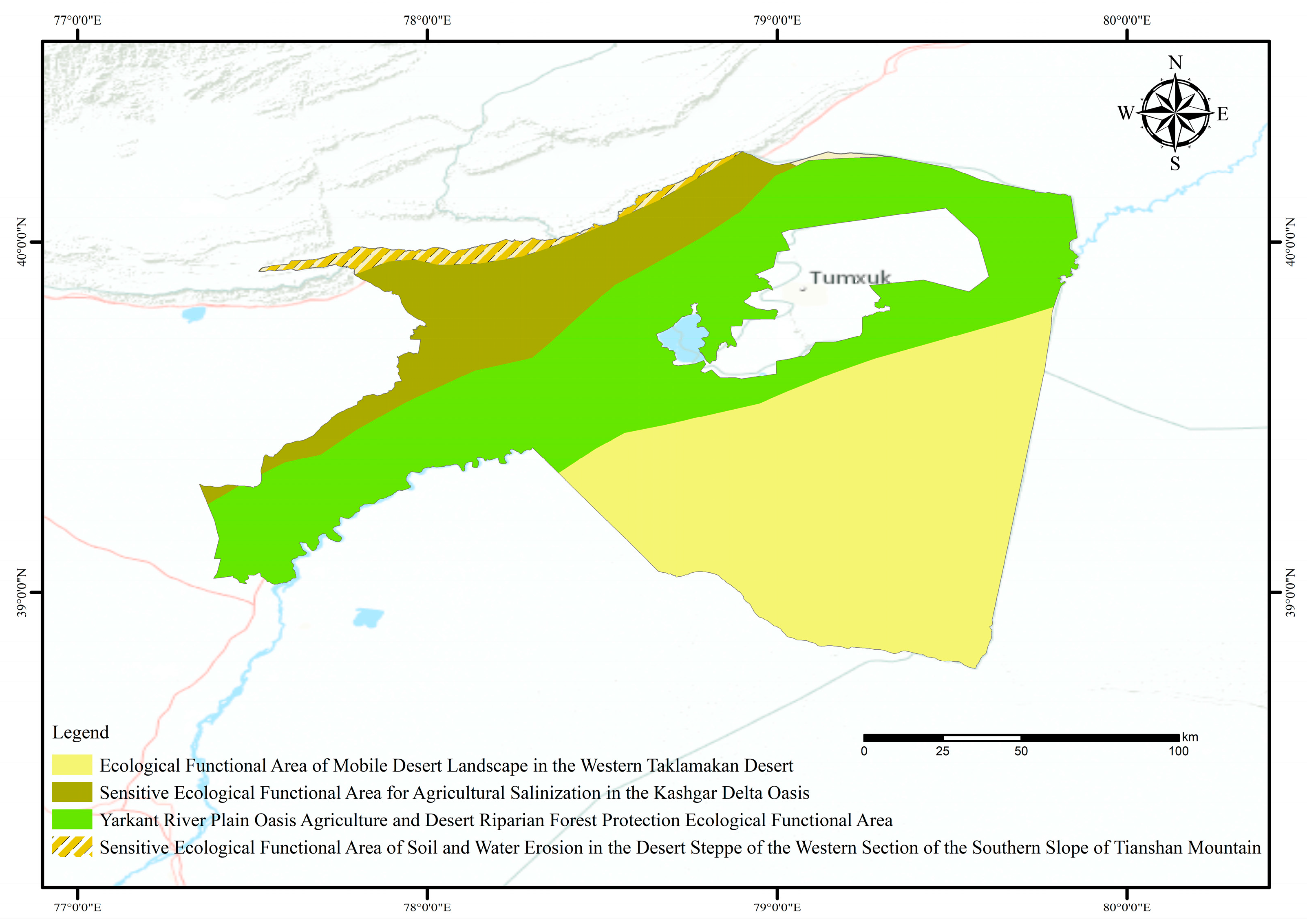


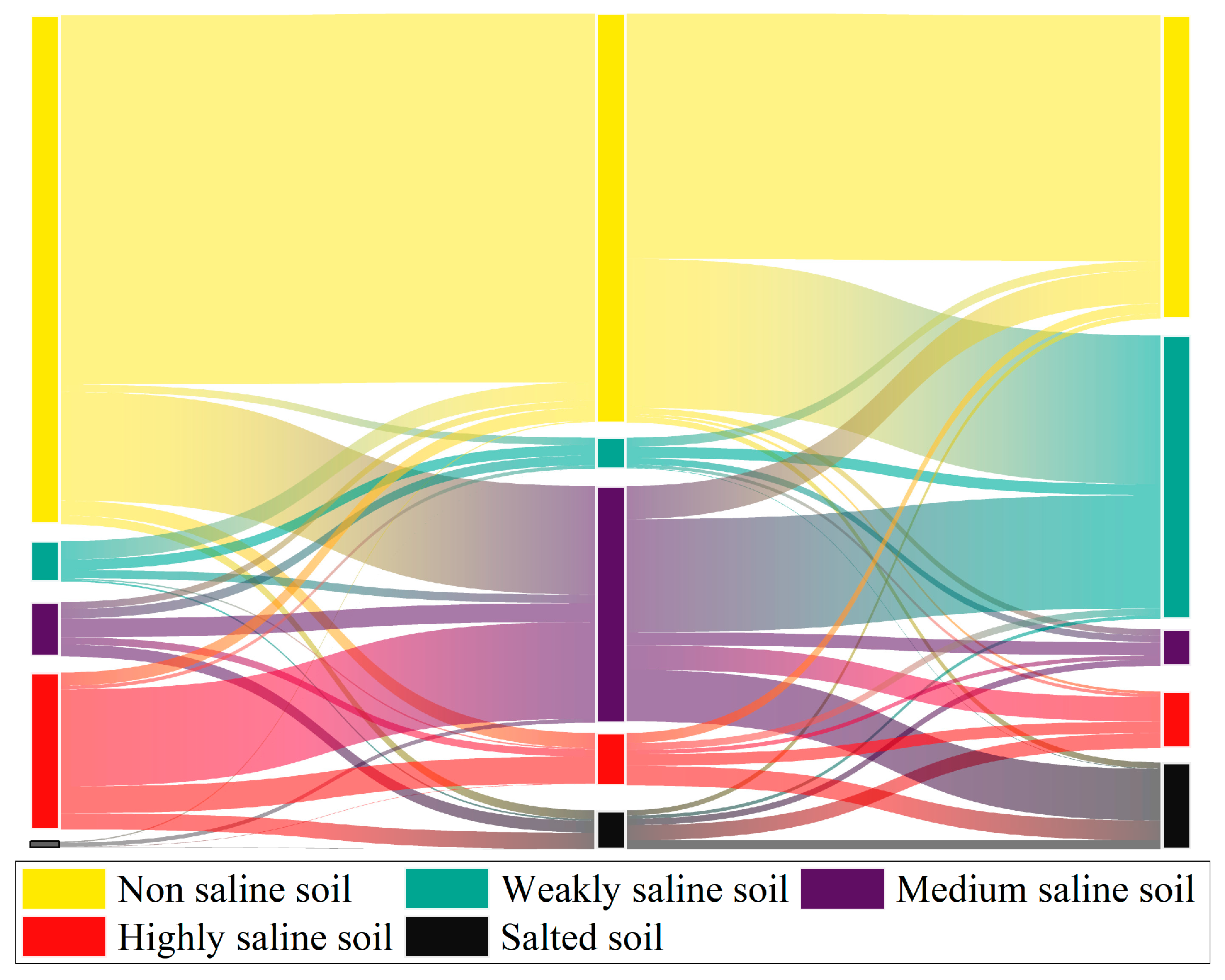
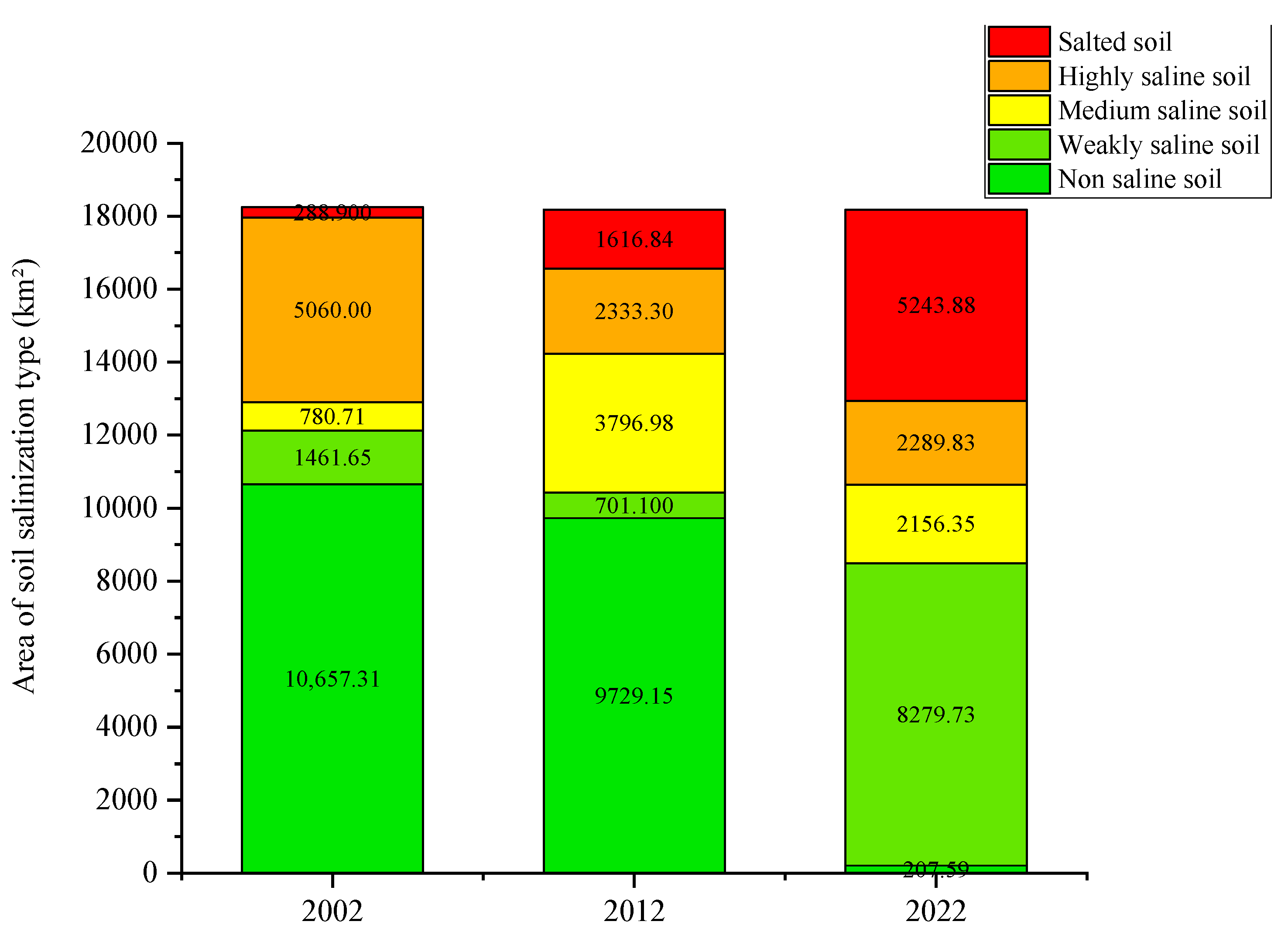

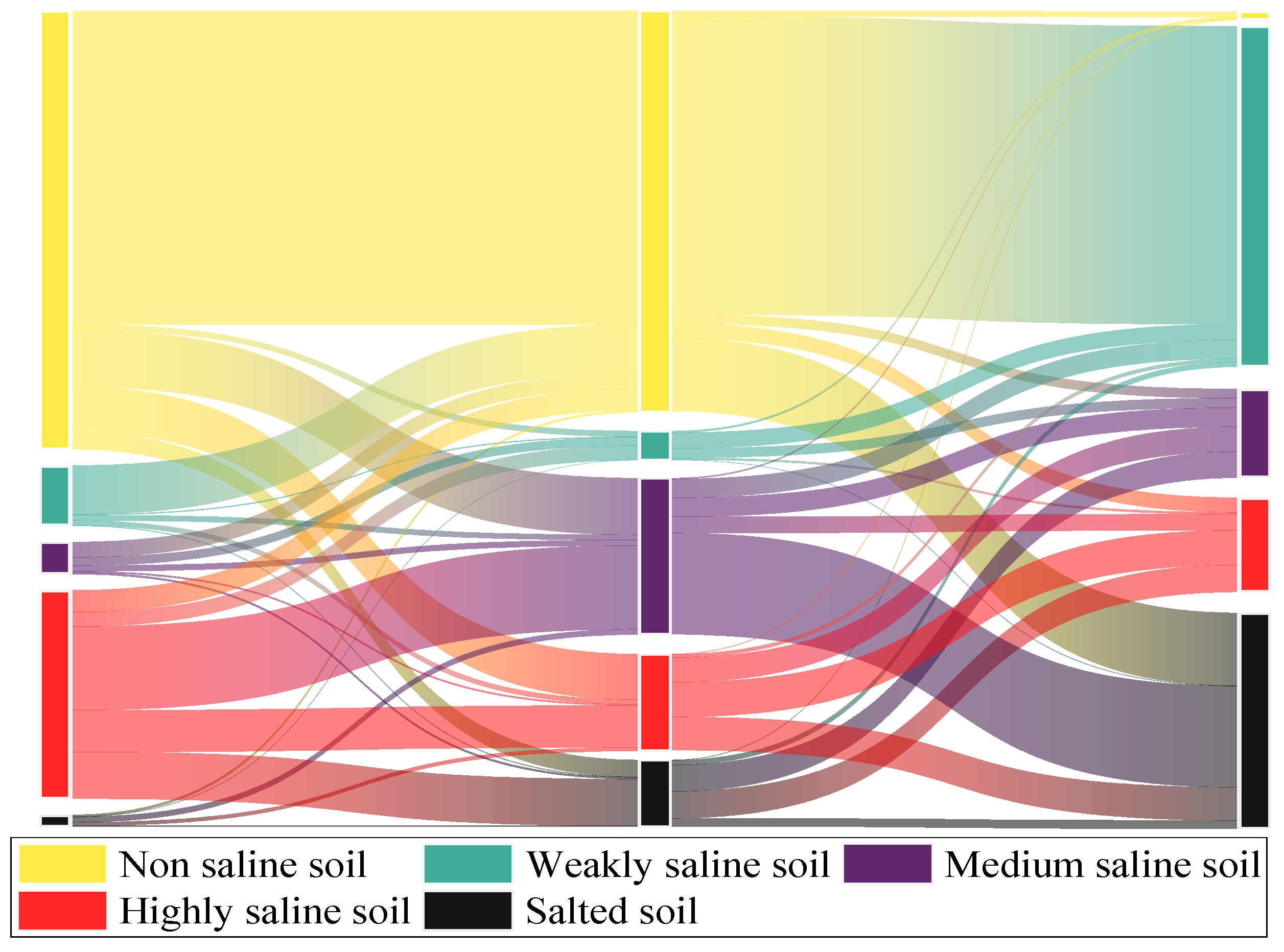

| Soil Impregnation Class | Non-Saline Soil | Weakly Saline Soil | Moderately Saline Soils | Highly Saline Soil | Saline Soil |
|---|---|---|---|---|---|
| Soil salinity (g·kg−1) | <3 | 3–6 | 6–10 | 10–20 | ≥20 |
| Serial Number | Pseudolaric Acid | Extract Data | Resolution (m) | Time Range of Values |
|---|---|---|---|---|
| 1 | Landsat7/9 | Single band, vegetation index, salinity index, composite index | 30 | April 2022, April 2012, April 2002 |
| 2 | MOD16A2 | Evapotranspiration | 500 | 2022 |
| 3 | CHIRPS Daily 2.0 Final | Precipitation | 500 | 2022 |
| 4 | SRTM | Elevation, slope, direction of slope | 30 | 2001 |
| Index | Formula | Reference |
|---|---|---|
| NDVI (normalized difference vegetation index) | [36] | |
| DVI (difference vegetation index) | [37] | |
| ERVI (enhanced red vegetation index) | [38] | |
| ENDVI (enhanced normalized difference vegetation index) | [39] | |
| CRSI (canopy redness index) | [19] | |
| MSAVI (modified soil-adjusted vegetation index) | [40] |
| Index | Formula | Reference |
|---|---|---|
| SI1 | [42] | |
| SI2 | [43] | |
| SI3 | [44] | |
| SI4 | [45] | |
| SI5 | [46] | |
| SI6 | [47] | |
| SI7 | [48] | |
| SI8 | [48] | |
| SI9 | [48] | |
| NDSI | [49] | |
| SI-T | [50] |
| Soil Depth | Model | R2 | RMSE/(g·kg−1) | MAE/(g·kg−1) |
|---|---|---|---|---|
| SSC (0–20 cm) | RF | 0.723 | 2.604 | 1.950 |
| SVM | 0.459 | 3.829 | 3.494 | |
| CART | 0.515 | 3.818 | 3.254 | |
| PLS | 0.678 | 2.666 | 2.278 | |
| SSC (20–40 cm) | RF | 0.64 | 3.620 | 2.728 |
| SVM | 0.316 | 3.940 | 3.501 | |
| CART | 0.503 | 3.820 | 3.390 | |
| PLS | 0.628 | 3.670 | 2.790 |
| Soil Salinity Class | 2012 Non-Saline Soil | 2012 Weakly Saline Soil | 2012 Moderately Saline Soils | 2012 Highly Saline Soil | 2012 Salted Soil |
|---|---|---|---|---|---|
| 2002 non-saline soil | 8779.19 km2 | 178.93 km2 | 2586.03 km2 | 355.94 km2 | 207.64 km2 |
| 2002 weakly saline soil | 437.08 km2 | 251.43 km2 | 200.60 km2 | 33.61 km2 | 40.24 km2 |
| 2002 moderately saline soil | 167.78 km2 | 226.38 km2 | 445.12 km2 | 175.19 km2 | 285.40 km2 |
| 2002 highly saline soil | 316.09 km2 | 84.89 km2 | 2308.85 km2 | 639.46 km2 | 386.43 km2 |
| 2002 salted soil | 27.18 km2 | 0.64 km2 | 95.68 km2 | 11.89 km2 | 6.99 km2 |
| Soil Salinity Class | 2022 Non-Saline Soil | 2022 Weakly Saline Soil | 2022 Moderately Saline Soil | 2022 Highly Saline Soil | 2022 Salted Soil |
|---|---|---|---|---|---|
| 2012 non-saline soil | 5843.76 km2 | 3541.94 km2 | 146.98 km2 | 62.48 km2 | 141.75 km2 |
| 2012 weakly saline soil | 218.78 km2 | 261.55 km2 | 161.08 km2 | 77.74 km2 | 13.73 km2 |
| 2012 moderately saline soils | 789.58 km2 | 2690.16 km2 | 308.75 km2 | 580.86 km2 | 1228.03 km2 |
| 2012 highly saline soil | 241.46 km2 | 168.14 km2 | 99.42 km2 | 276.02 km2 | 470.35 km2 |
| 2012 salted soil | 121.84 km2 | 79.79 km2 | 151.54 km2 | 358.35 km2 | 214.78 km2 |
| Soil Salinity Class | 2012 Non-Saline Soil | 2012 Weakly Saline Soil | 2012 Moderately Saline Soils | 2012 Highly Saline Soil | 2012 Salted Soil |
|---|---|---|---|---|---|
| 2002 non-saline soil | 7623.87 km2 | 136.01 km2 | 1377.66 km2 | 1106.79 km2 | 412.99 km2 |
| 2002 weakly saline soil | 1186.64 km2 | 19.45 km2 | 127.25 km2 | 116.12 km2 | 12.19 km2 |
| 2002 moderately saline soils | 373.05 km2 | 200.29 km2 | 136.03 km2 | 31.24 km2 | 40.11 km2 |
| 2002 highly saline soil | 529.88 km2 | 349.18 km2 | 2031.07 km2 | 1014.47 km2 | 1135.41 km2 |
| 2002 salted soil | 49.47 km2 | 1.26 km2 | 130.19 km2 | 85.04 km2 | 22.94 km2 |
| Soil Salinity Class | 2022 Non-Saline Soil | 2022 Weakly Saline Soil | 2022 Moderately Saline Soils | 2022 Highly Saline Soil | 2022 Salted Soil |
|---|---|---|---|---|---|
| 2012 non-saline soil | 135.22 km2 | 7245.48 km2 | 223.38 km2 | 353.55 km2 | 1771.51 km2 |
| 2012 weakly saline soil | 40.78 km2 | 379.57 km2 | 230.27 km2 | 45.22 km2 | 5.26 km2 |
| 2012 moderately saline soils | 22.93 km2 | 454.47 km2 | 464.74 km2 | 392.75 km2 | 2462.10 km2 |
| 2012 highly saline soil | 3.35 km2 | 81.27 km2 | 599.63 km2 | 844.82 km2 | 804.23 km2 |
| 2012 salted soil | 5.31 km2 | 118.93 km2 | 638.33 km2 | 653.48 km2 | 200.79 km2 |
Disclaimer/Publisher’s Note: The statements, opinions and data contained in all publications are solely those of the individual author(s) and contributor(s) and not of MDPI and/or the editor(s). MDPI and/or the editor(s) disclaim responsibility for any injury to people or property resulting from any ideas, methods, instructions or products referred to in the content. |
© 2024 by the authors. Licensee MDPI, Basel, Switzerland. This article is an open access article distributed under the terms and conditions of the Creative Commons Attribution (CC BY) license (https://creativecommons.org/licenses/by/4.0/).
Share and Cite
Zhang, Y.; Wu, H.; Kang, Y.; Fan, Y.; Wang, S.; Liu, Z.; He, F. Mapping the Soil Salinity Distribution and Analyzing Its Spatial and Temporal Changes in Bachu County, Xinjiang, Based on Google Earth Engine and Machine Learning. Agriculture 2024, 14, 630. https://doi.org/10.3390/agriculture14040630
Zhang Y, Wu H, Kang Y, Fan Y, Wang S, Liu Z, He F. Mapping the Soil Salinity Distribution and Analyzing Its Spatial and Temporal Changes in Bachu County, Xinjiang, Based on Google Earth Engine and Machine Learning. Agriculture. 2024; 14(4):630. https://doi.org/10.3390/agriculture14040630
Chicago/Turabian StyleZhang, Yue, Hongqi Wu, Yiliang Kang, Yanmin Fan, Shuaishuai Wang, Zhuo Liu, and Feifan He. 2024. "Mapping the Soil Salinity Distribution and Analyzing Its Spatial and Temporal Changes in Bachu County, Xinjiang, Based on Google Earth Engine and Machine Learning" Agriculture 14, no. 4: 630. https://doi.org/10.3390/agriculture14040630
APA StyleZhang, Y., Wu, H., Kang, Y., Fan, Y., Wang, S., Liu, Z., & He, F. (2024). Mapping the Soil Salinity Distribution and Analyzing Its Spatial and Temporal Changes in Bachu County, Xinjiang, Based on Google Earth Engine and Machine Learning. Agriculture, 14(4), 630. https://doi.org/10.3390/agriculture14040630






